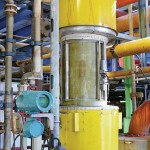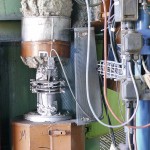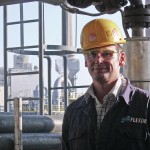It seems as though the flow rate could be miraculously measured by simply laying a hand on the pipe. However, the times of scepticism towards non-inva-sive ultrasonic flow measurement technology are over. Clamp-on ultrasonic technology is extremely popular. At the same time, not every measuring task is standard practice. High-temperature applications and non-invasive flow measurement of gases are still jobs to be done by specialists.
Jörg Sacher
Flow measurement with clamp-on ultrasonic technology means no wear and tear from the medium, no risk of leakages and no pressure loss. Since ultrasonic transducers are simply attached to the outside of the pipe, there is no need to carry out work on the piping. The measuring point is usually fitted without interrupting opera-tion. As is the case at many modern chemical companies, staff at Bayer Material-Science in Uerdingen appreciate the advantages of non-invasive measurements.
Bayer MaterialScience’s business is the plastics and chemical industry. With sales of EUR 7.5 billion in 2009, Bayer MaterialScience is among the world’s largest polymer manufacturers. As an independent company of the Bayer Group operating on a global scale, Bayer MaterialScience employs approximately 14,300 people at 30 locations around the globe. With some 4745 employees and over 50 % of overall sales, Polyurethane is the most important of Bayer MaterialScience’s three business divisions.
The isocyanates methylene diphenyl di-isocyanate (MDI) and toluylene diisocyanate (TDI) are crucial intermediate products in the production of polyurethane. MDI is a raw material that is particularly used to make rigid polyurethane foams. These foams have the best dye insulation performance of all materials currently available on the market and are utilised in cold chains as well as for heat insulation in the construction industry. TDI is used in large volumes to produce flexible polyurethane foam for upholstered furniture, mattresses and car seats.
Bayer MaterialScience operates a multi-line MDI plant at its Uerdingen site. All common measurement techniques are employed for flow measurements here; magnetic-inductive flow meters and measuring orifices, coriolis and vortex flow meters, in-line ultrasonic devices and clamp-on systems. According to Frank Baerendahls, a PCS production engineer who is responsible for the MDI plant’s measurement technology, staff in Uerdingen are delighted with the help and advice they receive from Flexim specialists with especially difficult measuring tasks. Heinrich Brucks is the expert responsible for Uerdingen.
Measurement of HCl gas
Hydrochloric acid is formed as a by-prod-uct during the production of MDI. It is then reprocessed and transferred to the Chlorine division at the Chempark plant in a concentration of approximately 32 %. The desired concentration is set by adding diluted acid to the HCl absorbers. In order to load them evenly and add the correct acid amount, the quantity of HCl gas must be measured at the inlet of the absorber. The facility cannot be operated without flow measurement at this point.
Due to the specific requirements regarding measurement reliability, this was conventionally done using a measuring orifice. However, even this apparently sound measuring equipment did not guarantee a satisfactory service life. In particular, the small tubes of the pressure transducer proved to be extremely susceptible to wear. The result was frequent leakages. Essential maintenance work means the system has to be shut down and involves an enormous amount of work. The pipelines are emptied and cleaned under compressed air conditions.
Trouble with leaking pressure transducers and plant downtimes for maintenance work on the measuring equipment are now a thing of the past since the installation of the Fluxus G clamp-on ultrasonic measuring system. Due to its working principle, non-invasive measuring technology has an advantage over measurements according to the pressure difference method. Measuring orifices only provide reasonably accurate measurements in a very limited range. The acoustic method, on the other hand, impresses with its high accuracy over an extremely wide spectrum.
Superior acoustics
Admittedly, measurement is not as easy as it might appear. “A few years ago no-one would ever have dared to imagine that the flow of gases could be measured non-invasively with clamp-on technology“, Heinrich Brucks recalls. The challenge lies in the difficult acoustic conditions. As with fluid flow measurements, the Fluxus G ultrasonic measuring systems also determine the flow of gases according to the transit time difference method. The acoustic transducers clamped onto the pipe send and receive ultrasonic signals which are directed both in and against the flow direction in the pipe. The flow velocity is calculated from the measured transit time difference and the geometry of the measuring point. Contrary to the undemanding and easy clamp-on flow measurement of fluids, only part of the sound enters the medium to be measured during gas measurement. The remaining sound that is produced stays in the pipe wall, where it acts as background noise. The measuring transducer effectively takes on the role of digital drudgery in the separation of wanted signals and disturbing signals. Since the density of the gas increases as the pressure rises and its acoustic impedance approaches that of the pipe wall, the ultrasonic signal is coupled considerably better at high pressures. Non-invasive measuring methods therefore work very well at high and extremely high operating pressures, which with many other methods are often associated with high costs and a great deal of effort. However, a slight vacuum of approximately -20 mbar prevails at the measuring point at the Uerdingen MDI plant.
“Thanks to the work of our developers, we have made significant progress in the last few years“, says Heinrich Brucks. Due to several improvements in all areas of signal generation, integration and processing, the minimum pressure required for non-inva-sive gas flow measurement has been reduced still further. As the aggressive and hazardous HCl gas is guided in PVDF plastic pipes with a GRP coating, the measuring signal is integrated extremely effectively into the medium. The relatively large pipe diameter (DN 400) is also not a problem for the Fluxus G 800 measuring transducer. Due to its significance, the measurement was carried out on two channels. The flow rates measured by the Fluxus G are fed into the process control system and used to automatically control the addition of diluted acid.
High-temperature measurement
Heinrich Brucks is also the expert for liquid flow measurements in Uerdingen. His expertise is particularly in demand when it comes to high-temperature applications. During the industrial production of MDI from diaminodiphenylmethane, a complex compound MDI oligomer mixture is first formed and then purified by distillation in several columns. In order to ensure safe and reliable processing, the various product flows must be measured continuously. This also includes the mass flow that is returned from the bottom area of the distillation column. In this case, high temperatures and viscous media place heavy demands on the reliability and efficiency of the flow meters.
Flexim installed a WaveInjector for flow measurement of the bottom product of MDI distillation. The patented high-temperature measuring device thermally separates the ultrasonic transducers of the Fluxus from the pipe while simultaneously ensuring their acoustic coupling. Non-invasive measurement technology is distinguished by a number of advantages: unlike vortex meters, which were previously used at this point for flow measurement, clamp-on flow transducers attached to the pipe outside are not subject to wear and tear from the medium, nor do they cause any pressure loss. In addition, the measuring system can be fitted easily without interrupting operation and without any work on the piping. The ultrasonic sensor installed instead of the wear-prone vortex meter failed to deliver permanently reliable measurement results. The ultrasonic measurement system comprised of the Fluxus and the WaveInjector now measures the return flow rate reliably and smoothly.
Online-Info www.cpp-net.com/2310444
Share:









